
Communication is the lifeblood of relationships, both personal and professional. However, barriers to effective communication can hinder the exchange of ideas, lead to misunderstandings, and strain relationships. 🫠
In this comprehensive guide, we will explore common barriers to communication and provide practical strategies to overcome them.
Whether you’re navigating workplace dynamics, fostering better connections with friends and family, or seeking to improve your overall communication skills, these insights will help you break down the walls that impede effective communication. 🙂
Let’s get started!
Understanding Barriers to Communication:
1. Lack of Clarity and Precision:
One of the fundamental barriers to effective communication is a lack of clarity. Vague or imprecise messages can lead to confusion and misinterpretation. It’s essential to articulate your thoughts clearly, using precise language and providing relevant details to ensure your message is accurately received. 😊
2. Emotional Barriers:
Emotional barriers, such as stress, anxiety, or strong emotions, can impede communication. When individuals are emotionally charged, they may struggle to express themselves clearly or be receptive to others. Managing emotions and creating a calm environment are crucial for effective communication.

3. Cultural and Language Differences:
Cultural and language diversity can create barriers to communication. Differences in language proficiency, communication styles, and cultural norms may lead to misunderstandings.
To overcome this barrier, it’s essential to foster cultural awareness, be patient with language differences, and use clear and straightforward language. 😊
4. Noise and Distractions:
Physical and environmental factors, such as noise and distractions, can interfere with communication. Whether it’s background noise, technological disruptions, or a busy environment, minimising distractions enhances the clarity and effectiveness of communication. 👂

5. Assumptions and Stereotypes:
Preconceived assumptions and stereotypes can create barriers by influencing how we interpret messages. Avoid making assumptions about others’ perspectives or intentions. Instead, approach communication with an open mind, seeking to understand diverse viewpoints without judgment. 🧠
6. Lack of Feedback:
Communication is a two-way process, and the absence of feedback can be a significant barrier. Encourage open dialogue, actively seek input from others, and provide constructive feedback. Creating a feedback loop ensures that messages are received and understood and not going in one ear and out the other.

7. Poor Listening Skills:
Ineffective listening is a pervasive barrier to communication. When individuals fail to actively listen, they miss important details, leading to misunderstandings. Improving listening skills involves giving full attention, avoiding interruptions, and practicing empathy to understand the speaker’s perspective. 😊
8. Power Dynamics and Hierarchies:
Unequal power dynamics or hierarchies within relationships or organisations can stifle open communication. Those in lower positions may feel hesitant to express their thoughts or concerns. Fostering an inclusive and open communication culture helps overcome these power-related barriers. 🫂
Strategies to Overcome Communication Barriers:
1. Prioritise Clarity in Communication:
- Articulate Clearly: Use clear and concise language when conveying your message. Avoid jargon or overly complex terms that may confuse the listener.
- Provide Context: Offer relevant background information to ensure your message is fully understood. Context helps the listener connect the dots and interpret your message accurately.
- Encourage Clarification: Create an environment where others feel comfortable seeking clarification. Encouraging questions can help address potential misunderstandings. 🤗

2. Emotional Intelligence and Regulation:
- Self-Awareness: Develop an understanding of your own emotions. Recognise how emotions may impact your communication style and be mindful of potential emotional triggers.
- Empathy: Practice putting yourself in others’ shoes. Empathetic communication involves understanding others’ perspectives and responding with sensitivity.
- Stress Management: Learn effective stress management techniques, such as deep breathing or mindfulness, to regulate emotions during challenging conversations.
Want to learn more about emotional intelligence? Check out this blog here: How to practice emotional regulation – tips for adults on how to cope
3. Cultural Sensitivity Training:
- Cultural Awareness: Educate yourself about different cultures, communication styles, and customs. A culturally aware approach fosters understanding and respect.
- Language Simplification: In multilingual settings, use simple language and avoid idioms or slang that may not translate well. Visual aids can also help enhance understanding. 🤗
- Inclusivity: Create an inclusive environment that values and celebrates cultural diversity. Encourage open discussions about cultural differences to promote understanding.
4. Create a Distraction-Free Environment:
- Choose Appropriate Settings: Select quiet and conducive environments for important conversations. Minimse disruptions by choosing a location with minimal background noise.
- Digital Etiquette: In digital communication, turn off notifications and ensure a stable internet connection. This helps maintain focus during virtual meetings or discussions. 🧑💻
- Active Presence: Demonstrate active presence by giving your full attention to the speaker. Make eye contact and eliminate distractions to signal that you are fully engaged.

5. Challenge Assumptions and Stereotypes:
- Open-Mindedness: Approach conversations with an open mind, avoiding preconceived notions. Be willing to challenge your assumptions and consider alternative perspectives.
- Promote Diversity and Inclusion: Actively promote diversity and inclusion in your personal and professional spheres. Encourage dialogue that challenges stereotypes and fosters a culture of acceptance.
- Educate Others: Share information that challenges common stereotypes. Education is a powerful tool in breaking down barriers and promoting understanding. 📖
6. Establish a Feedback Culture:
- Encourage Open Dialogue: Foster an environment where open dialogue is encouraged. Create channels for constructive feedback and ensure that all team members feel comfortable expressing their opinions. 🗣️
- Regular Check-Ins: Conduct regular check-ins to gather feedback on communication processes. Identify areas for improvement and implement changes based on the feedback received.
- Model Constructive Feedback: Lead by example by providing constructive feedback. Demonstrating how to give and receive feedback creates a culture of continuous improvement.
7. Enhance Listening Skills:
- Active Listening Techniques: Practice active listening by giving your full attention to the speaker. Avoid interrupting and provide feedback to demonstrate that you are engaged.
- Paraphrasing: Paraphrase the speaker’s message to confirm understanding. This not only clarifies information but also signals to the speaker that you are actively processing their words. 💬
- Empathetic Listening: Cultivate empathetic listening by trying to understand the emotions behind the words. Consider the speaker’s perspective and respond with empathy.
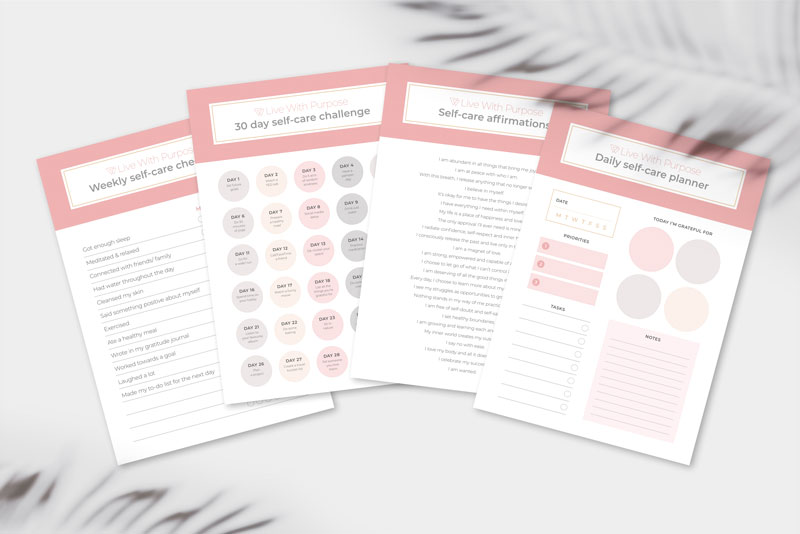
GRAB YOURSELF OUR FREE SELF-CARE BUNDLE!
It’s time to take some time out for yourself love! Check out this four-page bundle of self-care goodness that you can use to relax, refresh and rejuvenate. You deserve it sis.
Pop your info in and download your bundle now ❤️
8. Promote Inclusive Communication:
- Equal Participation: Encourage equal participation in discussions, regardless of hierarchical positions. Create platforms where everyone has the opportunity to voice their opinions and ideas.
- Team-building Activities: Foster a sense of unity within the team through team-building activities. Shared experiences can break down barriers and create a more cohesive group.
- Leadership Modeling: Leaders should model inclusive communication. By demonstrating openness to diverse perspectives and ideas, leaders set the tone for an inclusive organisational culture. 🏬
Real-Life Applications:
1. Workplace Communication:
- Clear Communication Channels: Establish clear communication channels within the workplace. This includes well-defined reporting structures, open-door policies, and regular team meetings.
- Conflict Resolution Workshops: Conduct workshops on conflict resolution to equip employees with the skills needed to navigate disagreements effectively. Emphasise active listening and constructive feedback.👂
2. Personal Relationships:
- Quality Time: In personal relationships, allocate quality time for meaningful conversations. Create an environment where both partners feel comfortable expressing their thoughts and emotions.
- Shared Activities: Engage in shared activities to strengthen bonds. Activities that foster communication, such as cooking together or participating in a hobby, provide opportunities for connection. 👨👩👧
Do you want to know your partner better? Check out our Relationship Planner.
3. Conflict Resolution:
- Mediation Training: Provide mediation training for individuals involved in conflict resolution. Equipping team members with mediation skills enhances their ability to facilitate productive discussions. 🧘♀️
- Establishing Common Ground: Identify common ground during conflicts. Finding shared values or goals can serve as a foundation for resolution and create a more collaborative atmosphere.
Conclusion:
Effectively overcoming barriers to communication involves a multifaceted approach that integrates self-awareness, empathy, and a commitment to fostering an inclusive environment. By implementing these strategies in various aspects of our lives, we can dismantle communication barriers and pave the way for stronger connections, collaboration, and understanding. 🤗
As we actively apply these strategies, we contribute to creating a culture of effective communication—one where diverse perspectives are valued, feedback is embraced, and relationships thrive. Breaking down the walls that hinder communication is a transformative journey that leads to more meaningful connections and a more harmonious and connected world.
Pin this post for a reminder 📌 👇
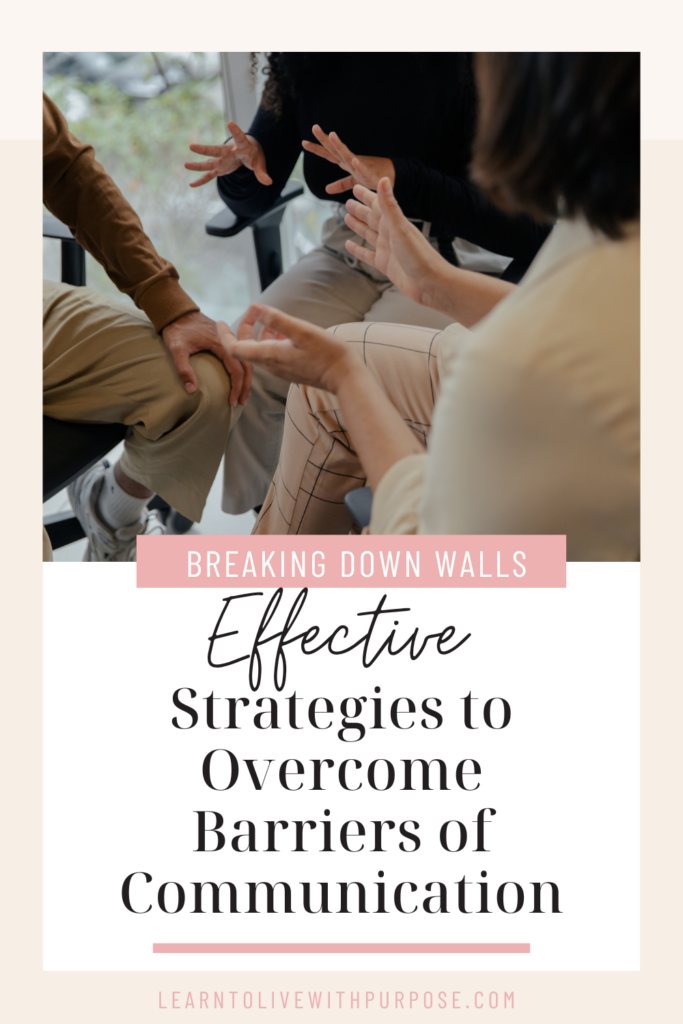
Related Blog
Things to Say “No” to for you to Live a Happier Life
How to Stop Settling For Less Than You Deserve
How to Become the Best Version of Yourself: A Guide For 20-Somethings
Communication is the lifeblood of relationships, both personal and professional. However, barriers to effective communication can hinder the exchange of ideas, lead to misunderstandings, and strain relationships. 🫠
In this comprehensive guide, we will explore common barriers to communication and provide practical strategies to overcome them.
Whether you’re navigating workplace dynamics, fostering better connections with friends and family, or seeking to improve your overall communication skills, these insights will help you break down the walls that impede effective communication. 🙂
Let’s get started!
Understanding Barriers to Communication:
1. Lack of Clarity and Precision:
One of the fundamental barriers to effective communication is a lack of clarity. Vague or imprecise messages can lead to confusion and misinterpretation. It’s essential to articulate your thoughts clearly, using precise language and providing relevant details to ensure your message is accurately received. 😊
2. Emotional Barriers:
Emotional barriers, such as stress, anxiety, or strong emotions, can impede communication. When individuals are emotionally charged, they may struggle to express themselves clearly or be receptive to others. Managing emotions and creating a calm environment are crucial for effective communication.

3. Cultural and Language Differences:
Cultural and language diversity can create barriers to communication. Differences in language proficiency, communication styles, and cultural norms may lead to misunderstandings.
To overcome this barrier, it’s essential to foster cultural awareness, be patient with language differences, and use clear and straightforward language. 😊
4. Noise and Distractions:
Physical and environmental factors, such as noise and distractions, can interfere with communication. Whether it’s background noise, technological disruptions, or a busy environment, minimising distractions enhances the clarity and effectiveness of communication. 👂

5. Assumptions and Stereotypes:
Preconceived assumptions and stereotypes can create barriers by influencing how we interpret messages. Avoid making assumptions about others’ perspectives or intentions. Instead, approach communication with an open mind, seeking to understand diverse viewpoints without judgment. 🧠
6. Lack of Feedback:
Communication is a two-way process, and the absence of feedback can be a significant barrier. Encourage open dialogue, actively seek input from others, and provide constructive feedback. Creating a feedback loop ensures that messages are received and understood and not going in one ear and out the other.

7. Poor Listening Skills:
Ineffective listening is a pervasive barrier to communication. When individuals fail to actively listen, they miss important details, leading to misunderstandings. Improving listening skills involves giving full attention, avoiding interruptions, and practicing empathy to understand the speaker’s perspective. 😊
8. Power Dynamics and Hierarchies:
Unequal power dynamics or hierarchies within relationships or organisations can stifle open communication. Those in lower positions may feel hesitant to express their thoughts or concerns. Fostering an inclusive and open communication culture helps overcome these power-related barriers. 🫂
Strategies to Overcome Communication Barriers:
1. Prioritise Clarity in Communication:
- Articulate Clearly: Use clear and concise language when conveying your message. Avoid jargon or overly complex terms that may confuse the listener.
- Provide Context: Offer relevant background information to ensure your message is fully understood. Context helps the listener connect the dots and interpret your message accurately.
- Encourage Clarification: Create an environment where others feel comfortable seeking clarification. Encouraging questions can help address potential misunderstandings. 🤗

2. Emotional Intelligence and Regulation:
- Self-Awareness: Develop an understanding of your own emotions. Recognise how emotions may impact your communication style and be mindful of potential emotional triggers.
- Empathy: Practice putting yourself in others’ shoes. Empathetic communication involves understanding others’ perspectives and responding with sensitivity.
- Stress Management: Learn effective stress management techniques, such as deep breathing or mindfulness, to regulate emotions during challenging conversations.
Want to learn more about emotional intelligence? Check out this blog here: How to practice emotional regulation – tips for adults on how to cope
3. Cultural Sensitivity Training:
- Cultural Awareness: Educate yourself about different cultures, communication styles, and customs. A culturally aware approach fosters understanding and respect.
- Language Simplification: In multilingual settings, use simple language and avoid idioms or slang that may not translate well. Visual aids can also help enhance understanding. 🤗
- Inclusivity: Create an inclusive environment that values and celebrates cultural diversity. Encourage open discussions about cultural differences to promote understanding.
4. Create a Distraction-Free Environment:
- Choose Appropriate Settings: Select quiet and conducive environments for important conversations. Minimse disruptions by choosing a location with minimal background noise.
- Digital Etiquette: In digital communication, turn off notifications and ensure a stable internet connection. This helps maintain focus during virtual meetings or discussions. 🧑💻
- Active Presence: Demonstrate active presence by giving your full attention to the speaker. Make eye contact and eliminate distractions to signal that you are fully engaged.

5. Challenge Assumptions and Stereotypes:
- Open-Mindedness: Approach conversations with an open mind, avoiding preconceived notions. Be willing to challenge your assumptions and consider alternative perspectives.
- Promote Diversity and Inclusion: Actively promote diversity and inclusion in your personal and professional spheres. Encourage dialogue that challenges stereotypes and fosters a culture of acceptance.
- Educate Others: Share information that challenges common stereotypes. Education is a powerful tool in breaking down barriers and promoting understanding. 📖
6. Establish a Feedback Culture:
- Encourage Open Dialogue: Foster an environment where open dialogue is encouraged. Create channels for constructive feedback and ensure that all team members feel comfortable expressing their opinions. 🗣️
- Regular Check-Ins: Conduct regular check-ins to gather feedback on communication processes. Identify areas for improvement and implement changes based on the feedback received.
- Model Constructive Feedback: Lead by example by providing constructive feedback. Demonstrating how to give and receive feedback creates a culture of continuous improvement.
7. Enhance Listening Skills:
- Active Listening Techniques: Practice active listening by giving your full attention to the speaker. Avoid interrupting and provide feedback to demonstrate that you are engaged.
- Paraphrasing: Paraphrase the speaker’s message to confirm understanding. This not only clarifies information but also signals to the speaker that you are actively processing their words. 💬
- Empathetic Listening: Cultivate empathetic listening by trying to understand the emotions behind the words. Consider the speaker’s perspective and respond with empathy.

GRAB YOURSELF OUR FREE SELF-CARE BUNDLE!
It’s time to take some time out for yourself love! Check out this four-page bundle of self-care goodness that you can use to relax, refresh and rejuvenate. You deserve it sis.
Pop your info in and download your bundle now ❤️
8. Promote Inclusive Communication:
- Equal Participation: Encourage equal participation in discussions, regardless of hierarchical positions. Create platforms where everyone has the opportunity to voice their opinions and ideas.
- Team-building Activities: Foster a sense of unity within the team through team-building activities. Shared experiences can break down barriers and create a more cohesive group.
- Leadership Modeling: Leaders should model inclusive communication. By demonstrating openness to diverse perspectives and ideas, leaders set the tone for an inclusive organisational culture. 🏬
Real-Life Applications:
1. Workplace Communication:
- Clear Communication Channels: Establish clear communication channels within the workplace. This includes well-defined reporting structures, open-door policies, and regular team meetings.
- Conflict Resolution Workshops: Conduct workshops on conflict resolution to equip employees with the skills needed to navigate disagreements effectively. Emphasise active listening and constructive feedback.👂
2. Personal Relationships:
- Quality Time: In personal relationships, allocate quality time for meaningful conversations. Create an environment where both partners feel comfortable expressing their thoughts and emotions.
- Shared Activities: Engage in shared activities to strengthen bonds. Activities that foster communication, such as cooking together or participating in a hobby, provide opportunities for connection. 👨👩👧
Do you want to know your partner better? Check out our Relationship Planner.
3. Conflict Resolution:
- Mediation Training: Provide mediation training for individuals involved in conflict resolution. Equipping team members with mediation skills enhances their ability to facilitate productive discussions. 🧘♀️
- Establishing Common Ground: Identify common ground during conflicts. Finding shared values or goals can serve as a foundation for resolution and create a more collaborative atmosphere.
Conclusion:
Effectively overcoming barriers to communication involves a multifaceted approach that integrates self-awareness, empathy, and a commitment to fostering an inclusive environment. By implementing these strategies in various aspects of our lives, we can dismantle communication barriers and pave the way for stronger connections, collaboration, and understanding. 🤗
As we actively apply these strategies, we contribute to creating a culture of effective communication—one where diverse perspectives are valued, feedback is embraced, and relationships thrive. Breaking down the walls that hinder communication is a transformative journey that leads to more meaningful connections and a more harmonious and connected world.
Pin this post for a reminder 📌 👇

Related Blog
Things to Say “No” to for you to Live a Happier Life
How to Stop Settling For Less Than You Deserve
How to Become the Best Version of Yourself: A Guide For 20-Somethings
We all want to succeed in life and reach our goals, but many of us are held back by a fear of failure. This fear can manifest itself in different ways: we may become anxious when faced with challenging tasks, procrastinate on important tasks, or even avoid taking risks altogether.
But the truth is that fear of failure is something that we can overcome, as these fears are formulated in our minds. By learning to be more mindful and developing the right strategies, we can start to unlock our potential and achieve our goals. 🫶
In this blog post, I’ll explore what the fear of failure is and why we have it, as well as share some strategies for overcoming your fear and unlocking your potential.
What is Fear of Failure?
Fear of failure is an emotional response that can arise when we are faced with a task or situation that we believe we may not be able to complete successfully. 😟
This fear can be triggered by a wide range of situations, from taking a test or starting a new job to making an important decision or taking on a new challenge.
When we feel that we may not be able to succeed in a certain task, we can experience a range of emotions including anxiety, fear, and even shame. This fear of failure can be so powerful that it can prevent us from taking risks, trying new things, and achieving our goals. 🙃
Recognising that failure is a normal and necessary part of personal growth and learning is essential. Learning from failures and using them as opportunities for improvement can help individuals cope with and eventually overcome this fear.
It’s important to remember that failure is not a reflection of a person’s worth, but rather a stepping stone on the path to success and personal development.

Reasons You Might Be Afraid of Failure
There are a number of reasons why we might be afraid of failure. One common reason is that we are afraid of disappointing others, especially if they have high expectations of us.
Another reason is that we may be worried about how we will be viewed by others if we fail. 👀
It is also possible that we may have experienced some form of failure in the past and feel that we are not capable of succeeding in the future.
We may also be afraid of failure because we believe that if we fail, we will not be able to move forward and achieve our goals.
Strategies to Overcome the Fear of Failure
Now that we have explored what fear of failure is and why we have it, it’s time to look at some strategies for overcoming it. Here are some tips for tackling your fear of failure and unlocking your potential:
Develop a Growth Mindset
One of the most effective ways to overcome the fear of failure is to develop a growth mindset. This involves looking at failure not as an end, but as an opportunity to learn and grow.
A growth mindset encourages us to take risks, embrace challenges, and look for ways to improve. It allows us to view failure as a learning experience and an opportunity to become better. 🤗
Take a look at our Personal Growth Bundle to find out more.
Visualise Success
Visualising success can be a powerful tool for overcoming fear of failure. Visualising ourselves succeeding can help us to be more confident, reduce anxiety, and take the first steps towards achieving our goals.
It is important to remember that visualising success does not mean that you will definitely succeed, but it can help you to build the confidence and motivation to take risks and move forward. 😀
To help with visualisation it would help to have a vision board. You can do this year by year or have an overview of the life you are trying to create. – Pinterest would be a great place to start with ideas.

Break Your Goals Into Smaller Steps
When we have a goal that we want to achieve, it can often seem like an insurmountable task. This can be overwhelming and can lead to fear of failure.
To help combat this fear, it is important to break your goals into smaller, achievable steps. This can help to make the task seem more manageable and reduce the fear of failure. 😊
Want to become a master at setting goals? Check out our mini-course: How to Set Goals and Achieve Them
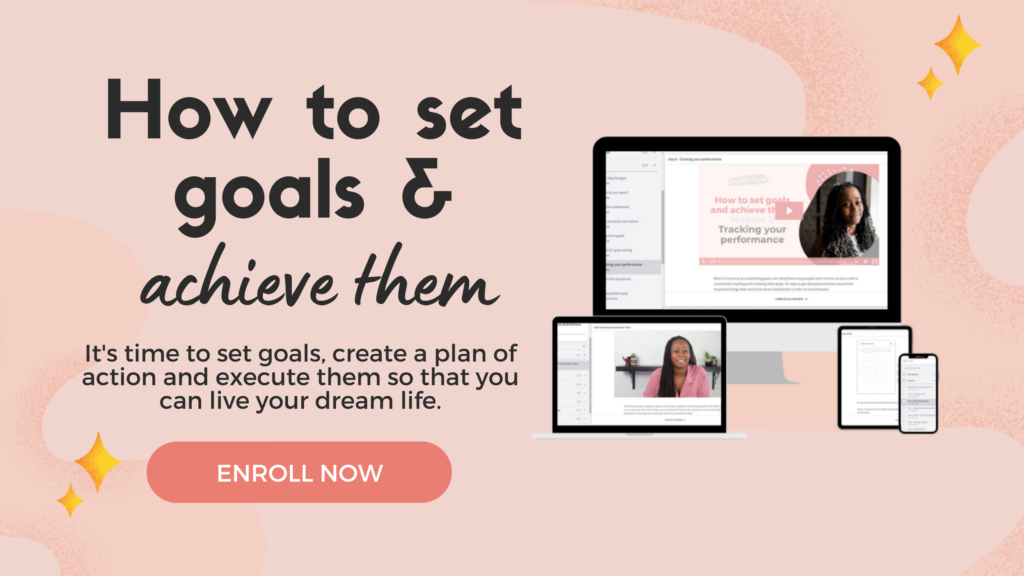
Accept That Failure is Part of the Process
It is important to remember that failure is part of the process of achieving your goals. Failure does not mean that you are not capable of achieving success, it either means that you have not found the right path yet or you just need to keep going. 🛣️
Don’t get me wrong, sometimes knowing when to quit and when to keep going can be hard. You have to think to yourself, am I going to regret this? or is this the best decision I can make for myself right now?
Accepting that failure is part of the process can help you to stay motivated and keep trying. It can also help to reduce the fear of failure and give you the confidence to take risks and try new things. 😊
Reach Out for Support
Reaching out for support can be a powerful tool for overcoming fear of failure. Talking to family, friends, and mentors can help to remind us that we are not alone and that there are people in our lives who are willing to help us. All you have to do is ask! 🗣️
Having a supportive network can also provide us with encouragement and motivation to keep going, even when we feel like giving up.

Celebrate Your Small Wins
It is important to celebrate our small wins and successes, no matter how small they may seem. Celebrating our successes can help to boost our confidence and remind us that we are capable of achieving our goals. Because you are! 🏆
It is also important to remember that failure does not define us; it is a part of the learning process. Acknowledging our successes, no matter how small, can help to keep us motivated and remind us that success is possible.
Conclusion – Unlocking Your Potential
Fear of failure can be a powerful emotion that can hold us back from achieving our goals. But with the right strategies, we can start to overcome our fear and unlock our potential.
By developing a growth mindset, visualising success, breaking our goals into smaller steps, accepting that failure is part of the process, reaching out for support, and celebrating our small wins, we can start to move forward and achieve our goals. 🎯
So don’t let your fear of failure stand in the way of your success. Start to take small steps today and unlock your potential!
Pin this post for a reminder 📌 👇

Related Blog
Things to Say “No” to for you to Live a Happier Life
How to Stop Settling For Less Than You Deserve
How to Become the Best Version of Yourself: A Guide For 20-Somethings
Have you ever found yourself staying up late to finish a work project that was not even your responsibility?
Or maybe you’ve felt overwhelmed because you’re constantly interrupted by coworkers while you’re trying to focus on your tasks. If so, it might be time to learn how to set boundaries in the workplace. 🤷♀️
Setting boundaries at work is a delicate art form. It’s about respecting your own needs and limits, while also respecting those of others. It’s about creating clear expectations for yourself and others and promoting a healthy work-life balance.
This is not about being selfish or uncooperative, but about maintaining your mental health and ensuring your productivity at work. 🧠
When we think of boundaries, we often think of physical boundaries. But in the workplace, boundaries can also be mental, emotional, and even digital. These boundaries are just as crucial for maintaining your well-being and productivity at work.
Importance of Setting Boundaries at Work
Establishing boundaries at work is vital for several reasons. First and foremost, it helps protect your mental and physical health. Constantly taking on extra work, dealing with interruptions, or feeling pressure to always be available can lead to stress, burnout, and even physical health problems.
At the end of the day… that’s not what you came to work for. 😑
Boundaries also help to improve productivity. When you set clear expectations about your availability and your workload, you can focus more effectively on your tasks without distractions or interruptions.
This enables you to perform your work more efficiently and effectively, which can improve your job satisfaction and career progression. 💼
Furthermore, setting boundaries can improve your relationships at work. When everyone understands each other’s boundaries, there is less chance for misunderstandings or conflicts. This leads to a more positive and respectful work environment, where everyone feels valued and heard.

Understanding the Challenges in Setting Boundaries
Setting boundaries at work is not always easy. One of the biggest challenges is the fear of how others will react. You may worry that you will be seen as uncooperative, lazy, or not a team player.
This fear can be especially strong in workplaces with a culture of overwork, where taking on extra work or being always available is seen as a sign of commitment and dedication.
Another challenge is the lack of clarity about what is expected of you. Without clear job descriptions or guidelines, it can be hard to know where your responsibilities begin and end, which makes it hard to set boundaries. 😬
Setting boundaries requires good communication skills. It requires being able to express your needs and limits clearly and assertively, without being aggressive or passive-aggressive. This is a skill that many people struggle with, but it can be learned and improved with practice! 😊
Steps to Effectively Set Boundaries in the Workplace
Setting boundaries at work involves several steps. The first step is to clarify your needs and limits. Think about what you need to do your job effectively and maintain your well-being.
This might include having uninterrupted time to focus on your work, not checking emails outside of working hours, or not taking on tasks that are not part of your job description. 📧
Once you have clarified your boundaries, the next step is to communicate them clearly. This involves expressing your needs and limits assertively, but also respectfully. It’s important to explain the reasons for your boundaries and be open to discussion and negotiation.
The final step is to enforce your boundaries. This means sticking to your limits, even when it’s uncomfortable or difficult. It also means dealing with boundary violations assertively and constructively, without resorting to aggression or passive aggression. 😇

Tips for Maintaining Boundaries with Coworkers
Maintaining boundaries with coworkers can be particularly tricky. Here are a few tips to help.
Firstly, lead by example. If you respect others’ boundaries, they are more likely to respect yours. 🤷♀️
Secondly, be consistent. If you enforce your boundaries sometimes but not others, people will get confused and may not take your boundaries seriously.
Finally, remember that it’s okay to say no. You don’t have to agree to every request or favour. It’s okay to prioritise your own needs and limits. You deserve it. ❤️
What does success mean to you? Take the quiz HERE

Strategies to Handle Boundary Violations
Unfortunately, even with clear communication, boundary violations can still occur. When this happens, it’s important to address the issue promptly and assertively. 🤷♀️
Start by calmly explaining the problem and why it’s a problem for you. Then, suggest a solution or alternative. If the violation continues, it may be necessary to involve a supervisor or HR.
At the end of the day.. you can’t make someone listen to you. So somtimes going above thier head is the only thing left to do. 🤷♀️
Role of Management in Reinforcing Workplace Boundaries
Management plays a crucial role in reinforcing workplace boundaries. They can set the tone for the workplace culture, provide clear expectations and guidelines, and model respectful behavior. 🤗
They can also support employees in setting and maintaining their boundaries, and intervene when boundary violations occur.
Here are few examples of what management should be doing:
- Monitoring Workload and Expectations:
- Managers should ensure that employees are not subjected to excessive workload or unreasonable expectations, which can lead to boundary violations.
- Recognising Achievements:
- Acknowledging and rewarding employees for maintaining healthy boundaries, promoting inclusivity, and contributing positively to the workplace reinforces the importance of these principles. 🙌
- Providing Feedback:
- Managers should offer constructive feedback to employees when necessary, addressing any boundary-related issues or inappropriate behavior in a supportive and non-punitive manner.

Conclusion: The Art of Mastering Workplace Boundaries
In conclusion, setting boundaries at work is a vital skill for maintaining your wellbeing and productivity, and fostering positive work relationships.
It’s not always easy, but with clarity, communication, and consistency, it’s definitely achievable. So don’t be afraid to stand up for your needs and limits. You deserve to work in an environment that respects and supports your boundaries. ❤️
Pin this post for a reminder 📌 👇

Related Blog
Things to Say “No” to for you to Live a Happier Life
How to Stop Settling For Less Than You Deserve
How to Become the Best Version of Yourself: A Guide For 20-Somethings
Identifying Energy-Draining Toxic Habits
Have you ever felt inexplicably drained, even after a good night’s sleep? If so, your daily habits might be the culprit.
Yes, you heard right – certain toxic habits can silently suck away your energy, leaving you feeling lethargic and unproductive. 🫠
These habits, while seemingly harmless, may be silently wreaking havoc on your physical and mental well-being. In this blog post, we’ll explore these energy-draining toxic habits and provide strategies on how to break away from them.
Often, these toxic habits are so deeply ingrained in our daily routines that we fail to identify them as the root cause of our constant fatigue. 😫
From incessant worrying to unhealthy eating, these habits can slyly infiltrate our lives, causing us to lose precious energy. The first step towards regaining your vitality is identifying these habits and acknowledging the need for change.
Remember, the goal here is not to shame or blame, but to bring awareness to these habits, so we can make informed decisions about our behaviors and lifestyles. By recognising these toxic habits, we open the door to a healthier, more vibrant life. 🥰
The Silent Threat of Negative Self-Talk
Negative self-talk is a toxic habit that can significantly drain your energy. The harmful effects of this habit are often underestimated, as it occurs within the privacy of our own minds.
Negative self-talk includes any inner dialogue that diminishes your self-worth or ability. These are the critical voices in your head that tell you that you’re not good enough, smart enough, or capable enough. 😰
The energy costs of negative self-talk are immense. Every negative thought depletes your energy reserves, leaving you feeling mentally and emotionally exhausted.
What’s more, negative self-talk can rob you of your motivation, making it challenging to pursue your goals or engage in activities you enjoy. 🫠
Combatting negative self-talk requires conscious effort. It involves being aware of your inner dialogue, challenging negative thoughts, and replacing them with positive affirmations. Remember, your mind believes what you tell it. So, fill it with positive, empowering thoughts.

The Energy Costs of Procrastination
Procrastination, the act of delaying or postponing tasks, is another toxic habit that can drain your energy. The energy drain from procrastination is twofold.
Firstly, the anxiety and guilt associated with procrastination can cause mental fatigue. Secondly, the energy required to rush through tasks at the last minute can lead to physical exhaustion. 😴
Procrastination often stems from a fear of failure or a lack of motivation. It’s essential to identify the root cause of your procrastination and address it head-on.
Breaking tasks down into manageable chunks and setting realistic deadlines can help overcome this habit. Remember, productivity fuels energy. The more tasks you complete, the more energised you’ll feel. 💪

The Trap of Perfectionism
Perfectionism, or the need to be flawless in everything you do, is another toxic habit that can deplete your energy.
While striving for excellence is commendable, an unrelenting pursuit of perfection can lead to stress, burnout, and decreased productivity. The constant pressure to be perfect can leave you feeling mentally exhausted and physically drained. 😥
The key to overcoming perfectionism lies in embracing imperfection.
Realise that it’s okay to make mistakes and that no one is perfect. NO ONE. Even if they’re life seems perfect from the outside, it never is. Learn to appreciate your efforts and stop comparing your progress with others. Remember, progress, not perfection, is the goal. 😉
The Harm Caused by Excessive Worrying
While it’s natural to worry about life’s uncertainties, constant worrying can lead to anxiety and stress, which are significant energy zappers.
Additionally, worrying can disrupt your sleep, further depleting your energy reserves. 😴
To combat excessive worrying, try practicing mindfulness and relaxation techniques like yoga and meditation. These practices can help calm your mind and reduce your stress levels, thereby conserving your energy.
You can learn more about mindfulness and meditation in The Keys to Self-Mastery eBook
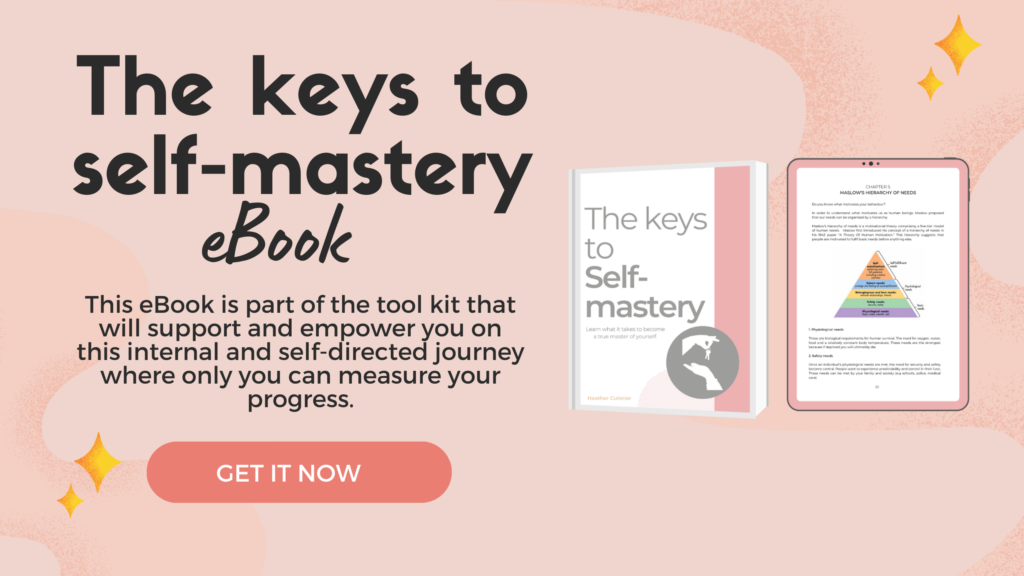
The Cost of Holding onto Grudges
Holding onto grudges is another toxic habit that can drain your energy and time. Harbouring resentment or anger towards others can lead to emotional exhaustion. Also, it can rob you of your peace of mind and happiness, leaving you feeling drained. 😒
To break free from this habit, practice forgiveness and let go of past hurts. Remember, holding a grudge is like drinking poison and expecting the other person to die. By forgiving others, you free yourself from the burden of resentment, thereby conserving your energy.
You don’t need to continue to talk to them or have them in your life if it’s going to affect your peace. Leave them where they are and move on. 🚶♀️
The Burden of Not Setting Boundaries
Not setting boundaries is another toxic habit that can drain your energy. Without boundaries, you can easily become overwhelmed with responsibilities and commitments, leading to burnout.
Moreover, allowing others to overstep your boundaries can lead to feelings of resentment and frustration, further draining your energy and time. 😑
To establish healthy boundaries, learn to say no when necessary and prioritize your needs. Remember, you can’t pour from an empty cup.
By setting boundaries, you protect your energy and ensure that you have enough left to take care of yourself. 🥰

The Price of Unhealthy Eating Habits
Unhealthy eating habits are another major drain on your energy. Consuming processed foods, sugary snacks, and caffeinated beverages can give you a quick energy boost, but they often lead to an energy crash later. 😴
These foods lack the essential nutrients your body needs to function optimally, leading to fatigue and lethargy.
To boost your energy levels, focus on consuming nutrient-dense foods that provide sustained energy, like whole grains, fruits, vegetables, lean proteins, and healthy fats. 🥗
Remember, your diet is a crucial part of your energy equation. By making healthier food choices, you can significantly increase your energy levels.
The Impact of Lack of Physical Activity
Lack of physical activity is another toxic habit that can make you feel like bluh. Regular exercise boosts your energy levels by increasing your heart rate and circulation, improving your sleep, and reducing your stress levels. 😌
On the other hand, a sedentary lifestyle can lead to fatigue, poor sleep, and decreased motivation.
To increase your energy levels, incorporate regular physical activity into your routine. This could be anything from a brisk walk to a high-intensity workout. Remember, movement is energy. 🤸♀️
The more active you are, the more energised you’ll feel. So make it a habit to get up and move daily!

Strategies for Breaking Away from Toxic Habits
Breaking away from toxic habits can be challenging, but it’s not impossible. The first step is to identify the habits that are draining your energy.
Once you’ve identified these habits, you can start working on strategies to overcome them. These strategies can include practicing positive self-talk, setting realistic goals, learning to manage stress, practicing forgiveness, setting healthy boundaries, maintaining a balanced diet, and incorporating regular physical activity into your routine. 🥰
P.S. You can find worksheets to help you with all of the above in my Etsy Store and the Printables on my site.
Remember, breaking away from toxic habits is a journey, not a destination. It requires patience, perseverance, and commitment. But the rewards are well worth the effort.
By freeing yourself from these energy-draining habits, you open the door to a healthier, more invigorated life. 🥹
Conclusion: Embracing Positive Habits for an Energy-Full Life
In conclusion, we all have toxic habits that can drain our energy. However, by identifying these habits and working on strategies to overcome them, we can break free from their hold and reclaim our energy.
Remember, the goal is not to be perfect, but to be better. Every small step you take towards breaking these habits counts. So, start today, and embrace the journey towards an energy-full life. ❤️
Pin this post for a reminder 📌 👇

Related Blog
Things to Say “No” to for you to Live a Happier Life
Life Audit and its Importance
Have you ever felt like you’re not moving forward in life? Like you’re stuck in a rut, and despite your best efforts, you can’t seem to break free? 🤔
If you’ve experienced this you’re not alone my friend. It’s a feeling that many of us grapple with at various points in our lives. This is where the concept of a life audit comes in, a strategic method of taking stock of your life and aligning it with your goals.
A life audit is essentially a comprehensive evaluation of your life’s current state. It involves examining your values, goals, accomplishments, and areas of improvement. 🧘
This process allows you to understand where you stand and what you need to do to get where you want to be. It’s not about judging yourself or feeling guilty about unaccomplished goals; it’s about understanding and strategising for your future.
The importance of a life audit cannot be overstated. It helps in identifying the disconnect between your aspirations and your current reality. 🙂
By doing so, it allows you to make necessary changes and adjustments to align your life with your goals. It’s about taking control of your life, rather than being controlled by it.

Defining Your Personal and Professional Goals
The first step in a life audit is defining your personal and professional goals. What do you want to achieve in your life? What’s your vision for your future? These are some of the questions that you need to answer.
It’s important to be specific and realistic when setting your goals. For instance, instead of saying “I want to be rich,” you might say “I want to save £1 million by the time I’m 50.” Then you can go deeper than that and describe how you’re going to do so. 🤔
Working your way backward will show you the steps that you will need to take in order to reach your goals.
Your goals should be a reflection of your values and passions. They should excite you and motivate you to take action. They should also be flexible, allowing room for change and growth. Remember, your goals are not set in stone; they can evolve as you do. 😊
Defining your goals is not just about creating a roadmap for your future; it’s about understanding who you are and what you want from life.
It’s about finding your purpose and pursuing it with determination and perseverance. ❤️
The Role of a Life Audit in Mastering Your Goals
A life audit plays a crucial role in mastering your goals. It provides a clear picture of your current situation, allowing you to understand where you are in relation to your goals.
It highlights the gaps and discrepancies in your life, making it easier to devise a plan of action. 💪
By conducting a life audit, you can identify the obstacles that are hindering your progress. These may include negative thought patterns, unhealthy relationships, or unproductive habits.
Once identified, you can work on overcoming these obstacles, paving the way for your success.
Furthermore, a life audit allows you to assess the effectiveness of your strategies and actions. Are you moving closer to your goals? Are your efforts yielding the desired results? If not, you can adjust your strategies and actions accordingly. 🤷

Simple Steps to Conduct a Life Audit
Conducting a life audit may seem daunting, but it doesn’t have to be. Here are some simple steps to guide you through the process:
Step 1: Define your values. What matters most to you in life? What are your core beliefs and principles?
Step 2: Identify your goals. What do you want to achieve in your personal and professional life? 🤔
Step 3: Evaluate your current situation. Where are you in relation to your goals? What’s working and what’s not?
Step 4: Identify the gaps and obstacles. What’s preventing you from achieving your goals? How can you overcome these challenges?
Step 5: Devise a plan of action. How will you move forward? What steps will you take to achieve your goals?
Step 6: Implement your plan. Take action and monitor your progress. Adjust your plan as necessary. 😄
How to Analyse the Results of a Life Audit
Analysing the results of a life audit is just as important as conducting it. This is where you get to see the fruits of your labor – the insights and revelations that will guide your journey towards your goals. 🏆
When analysing the results, focus on the gaps and discrepancies. These are the areas that need your attention.
Identify the steps you need to take to bridge these gaps. Remember, small steps can lead to big changes. 👣
Also, pay attention to the positives. What are you doing well? What are your strengths? Celebrate your wins, no matter how small they may be, they’re still wins.
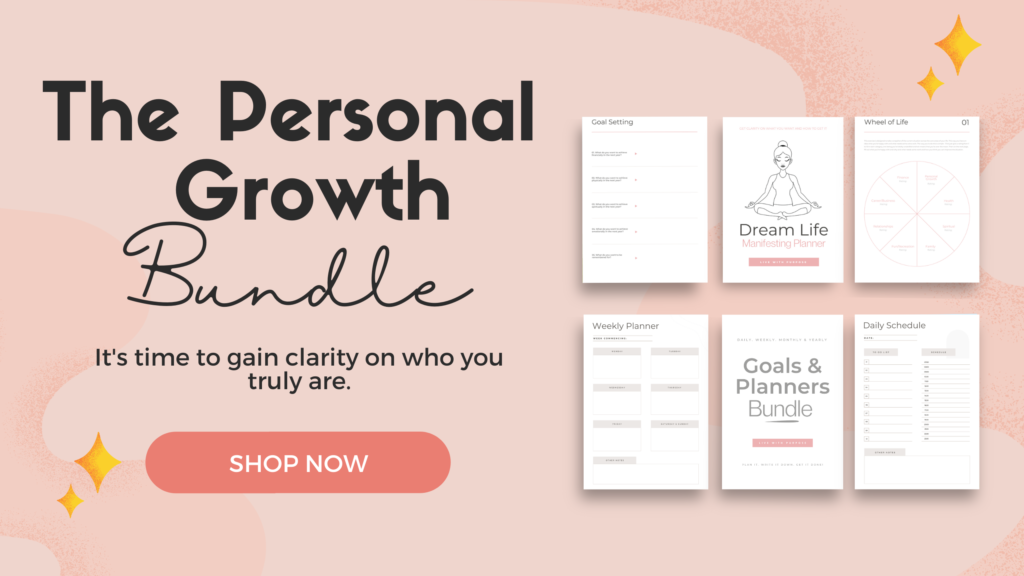
Case Study: Successful Life Audit and Goal Setting
Consider the case of Haley, a mid-level manager in a multinational company. She was feeling stuck in her career and wanted more from life. She decided to conduct a life audit.
Haley started by defining her values and identifying her goals. She realised that she valued personal growth and creativity, but her current job didn’t offer much room for either. Her goal was to have a career that allowed her to use her creative skills and grow professionally. 😄
Haley evaluated her current situation, identifying the gaps and obstacles. She realised that her lack of creative skills was the main obstacle. She devised a plan of action, which included taking online courses to enhance her skills. 🖥️
Haley implemented her plan and monitored her progress. She took the courses and started applying her newly acquired skills at work. His efforts paid off – she was promoted to a higher-level position that allowed her to use his creative skills.
Haley’s story illustrates the power of a life audit. It enables you to take control of your life and steer it in the direction of your dreams.
This is what I want for you! 💕
Overcoming Challenges During a Life Audit
Conducting a life audit can be challenging. It requires introspection, honesty, and courage. You may encounter resistance from within – fear of change, self-doubt, or procrastination.
However, remember that growth lies outside your comfort zone. Embrace the challenges and turn them into opportunities for growth. 🪴
It’s also important to be patient with yourself. Change takes time. Don’t beat yourself up if you don’t see immediate results. Keep moving forward, one step at a time. 🤗
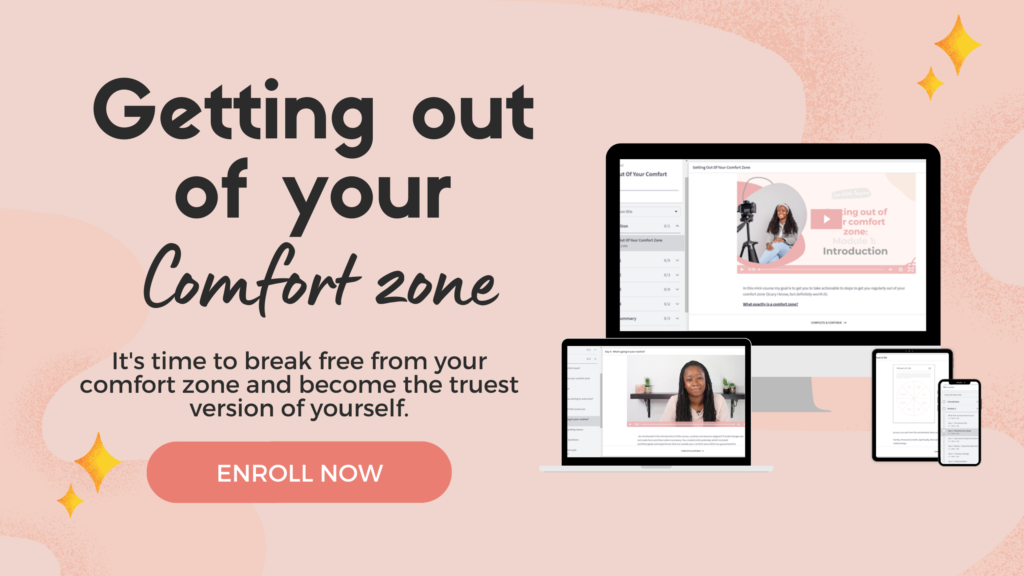
Tools and Resources for a Successful Life Audit
There are several tools and resources that can aid you in your life audit journey. Journaling is a powerful tool that can help you gain clarity and insight.
It allows you to express your thoughts and feelings, making sense of your experiences. 🙂
Online platforms like LifeTick and GoalsOnTrack provide tools and resources for goal setting and tracking. They can help you stay focused and motivated in your journey.
Books like “The Life Audit” by Caroline Righton and “The Desire Map” by Danielle LaPorte provide practical guidance on conducting a life audit. 🕮

How to Maintain Progress After a Life Audit
Maintaining progress after a life audit is crucial. It’s easy to fall back into old patterns and habits.
To avoid this, keep track of your progress. Celebrate your wins and learn from your mistakes. Stay focused on your goals and remind yourself of why they are important to you. 🥰
Remember that a life audit is not a one-time event; it’s an ongoing process. Regularly revisit your goals and adjust them as necessary. Stay open to change and growth.
Conclusion
Let’s face it, a life audit is a powerful tool that can transform your life. ❤️
It provides clarity, focus, and motivation, enabling you to master your goals. It’s about taking control of your life and steering it in the direction of your dreams.
So, are you ready to conduct your life audit?
The time to start is now. 🕗
Pin this post for a reminder 📌 👇

Related Blogs
The Top 10 Reasons Why People Don’t Reach Success
The Importance of Making Time for Yourself
As life gets busier, it becomes increasingly challenging to find time for oneself. However, it is an essential aspect of maintaining a balanced and healthy lifestyle. 🧘♀️
Making time for yourself allows for relaxation, reflection, and rejuvenation. It is an opportunity to disconnect from daily stresses and recharge your mental and emotional batteries.
Time for yourself is not a luxury, but a necessity. It is as crucial as eating a balanced diet or exercising regularly. Without it, we can become overwhelmed, stressed, and burnt out. In the long run, neglecting personal time can lead to serious health problems, both physical and psychological. 😬
The hustle and bustle of modern life often make us feel guilty about taking time out for ourselves. We are conditioned to think that being constantly busy is a sign of productivity and success.
However, this is a false belief. Making time for yourself is not a sign of laziness or selfishness. It is self-care, and it is crucial for your overall well-being and productivity.

Understanding the Concept of ‘Me Time’
‘Me Time’ is a term that is thrown around a lot these days. But what does it really mean? Simply put, ‘me time’ refers to the time set aside for doing things that you enjoy, that relax you, or that allow you to be alone with your thoughts. It is a time when you are not accountable to anyone else, not your boss, not your family, not your friends.
Just you. 👑
‘Me time’ can be anything from reading a book, going for a walk, practicing yoga, gardening, or simply sitting quietly with a cup of tea.
It is not about what you do; it is about being present and engaged in what you are doing. It is about being mindful and enjoying the moment.
‘Me time’ is not about escapism or avoiding responsibilities. It is about balancing your needs with those of others. It is about understanding that you cannot pour from an empty cup. You need to take care of yourself first to be able to take care of others. 👭
The Benefits of Making Time for Yourself
Making time for yourself has numerous benefits. First and foremost, it reduces stress. 🛀
When you take time out to do something you enjoy, your body releases endorphins – the ‘feel good’ hormones. This reduces stress levels and boosts your mood.
Secondly, making time for yourself increases productivity. When you take breaks, you allow your mind to rest and recharge. This increases your focus and concentration, making you more efficient and productive.
Thirdly, making time for yourself improves your relationships. When you are relaxed and happy, you are more likely to be patient and understanding with others. This improves your relationships and makes you a better partner, parent, and friend. 👪
Furthermore, making time for yourself boosts your self-esteem. When you take care of yourself, you send a message to your subconscious that you are worthy of care. This boosts your self-esteem and improves your overall mental health.

Strategies to Make Time for Yourself Amidst a Busy Schedule
Doing things for yourself amidst a busy schedule may seem impossible, but it is not. With a little planning and prioritisation, you can find pockets of time for yourself every day and I mean every day. 🤷♀️
The first strategy is to schedule your ‘me time’. Just like you schedule meetings or appointments, schedule time for yourself. Block out a specific time each day for self-care. This could be in the morning before everyone else wakes up, during lunch breaks, or in the evening after everyone else has gone to bed.
The second strategy is to delegate tasks. Often, we take on more than we can handle, leaving no time for ourselves. Just work, work, work. Learn to delegate tasks to others, be it at home or at work. This will free up some time for you.There’s no need for you to do everything ad burn yourself out. 🙃
The third strategy is to say “No”. You cannot do everything for everyone all the time. Learn to say no to tasks or commitments that are not essential or do not bring you joy.
FREE SELF-CARE BUNDLE

GRAB YOURSELF OUR FREE SELF-CARE BUNDLE!
It’s time to take some time out for yourself love! Check out this four-page bundle of self-care goodness that you can use to relax, refresh and rejuvenate. You deserve it sis.
Pop your info in and download your bundle now ❤️
Practical Tips to Prioritise ‘Me Time’
Prioritising ‘me time’ is crucial to making it a reality. We are all about action over here! 💕
Here are some practical tips to help you prioritize ‘me time’.
Firstly, identify what you enjoy doing. What activities relax you? What hobbies do you enjoy? Make a list and keep it handy.
Secondly, plan your week ahead. Identify pockets of free time and schedule your ‘me time’ activities. Be flexible and willing to adjust as necessary.
Thirdly, set boundaries. Let those around you know about your ‘me time’ and request their support and understanding. Make it clear that this time is non-negotiable.
Lastly, be consistent. Make ‘me time’ a regular part of your routine. Consistency is key to making it a habit.
Speaking of building habits why don’t you check out our Personal Growth Bundle? It does what it says on the tin. 😉

Successful Individuals Who Make Time for Themselves
There are many successful individuals who understand the importance of making time for themselves and have integrated it into their daily routines.
Take for example, Bill Gates, co-founder of Microsoft. He is known for taking a week off twice a year for ‘think weeks’. During this time, he disconnects from work and spends time alone, reading and thinking. 🧠
Similarly, Oprah Winfrey, a media mogul and philanthropist, starts her day with 20 minutes of meditation. She believes that this self-care practice sets the tone for the rest of the day and keeps her centered and balanced.
These examples show that making time for yourself is not a luxury, but a necessity for success, productivity, and well-being. 🙂
Overcoming Obstacles: Dealing with Guilt and Other Barriers
One of the major barriers to making time for yourself is guilt. Many people feel guilty about taking time out for themselves. They feel that they should be doing something ‘productive’ or ‘useful’ instead. 🙃
The key to overcoming this guilt is to change your mindset. Understand that making time for yourself is productive.
It’s productive because it recharges your batteries and makes you more efficient and effective in the long run.
Another barrier is time. Many people feel that they do not have enough time to spare for themselves. The key to overcoming this barrier is effective time management. Prioritise your tasks, delegate, and learn to say no to non-essential tasks. 🙅♀️
Your time is precious! You don’t want to look back and wish you spent more time focusing on your wants and needs.
Incorporating ‘Me Time’ into Your Daily Routine
Incorporating ‘me time’ into your daily routine can be achieved in several ways.
Firstly, wake up a little earlier and spend the first 30 minutes of your day doing something you enjoy. This could be reading, exercising, meditating, or simply sipping your coffee in peace. ☕
Secondly, you can incorporate ‘me time’ into your lunch break. Instead of working through your lunch break, take a walk, read a book, or listen to your favorite podcast.
Thirdly, you can end your day with ‘me time’. Spend the last 30 minutes before bedtime doing something relaxing, like spending time with family, taking a bath, or practicing yoga. 👨👩👧
Tools and Resources to Help You Make Time for Yourself
There are many tools and resources available! These include time management apps, self-care apps, books on self-care, and online courses on time management and self-care. 🛀
Time management apps, like Todoist or Toggl, can help you organise your tasks and manage your time more effectively.
Self-care apps, like Calm or Headspace, can guide you through meditation sessions, provide relaxing music, or suggest self-care activities. 🧘♀️
There are also many books and online courses available on the subject of self-care and time management. These can provide valuable insights and practical tips to help you make time for yourself.

Conclusion: It’s Time to Revolutionise Your Routine
In conclusion, making time for yourself is crucial for your overall well-being and productivity.
It is not a luxury, but a necessity. So, revolutionise your routine, make time for yourself, and see the difference it makes in your life. 😁
Remember, you are worthy of love and happiness. The journey to self-love starts with a single step, so take that step today and start loving yourself today. 💖
Pin this post for a reminder 📌 👇

Related Blog
Things to Say “No” to for you to Live a Happier Life
How to Stop Settling For Less Than You Deserve
How to Become the Best Version of Yourself: A Guide For 20-Somethings
In today’s fast-paced and ever-changing world, it’s more important than ever to invest in yourself.
With the constant demands placed upon us by work, family, and ourselves, it can be all too easy to neglect our own personal growth and development. 😑
However, the most successful and fulfilled individuals understand the importance of making self-investment a priority. In this blog, I’ll explore the top 10 ways you can invest in yourself to build a brighter future and unlock your full potential.
Let’s go! 🙌
Introduction to Investing in Yourself
Investing in yourself is about dedicating time, energy, and resources toward your personal growth and self-improvement. 😀
It’s about recognising your worth and understanding that the best investment you can make is in your own development. By prioritising self-investment, you’re not only enhancing your current skills and abilities but also preparing yourself for future opportunities and challenges.
In essence, investing in yourself is the key to unlocking a fulfilling and successful life. 💁♀️

Importance of Self-Investment for Personal Growth and Success
Self-investment is crucial for personal growth and success for several reasons.
First, it allows you to continually evolve and adapt to the changing world around you.
By actively seeking out new skills and knowledge, you’re able to stay ahead of the curve and remain competitive in your field. 🏆
Second, investing in yourself boosts your self-esteem and sense of self-worth. When you take the time to nurture your mind, body, and soul, you send a powerful message to yourself and the world that you are valuable, deserving, and capable of greatness. 💕
Finally, self-investment helps you to build resilience and navigate life’s inevitable setbacks with greater ease.
RELATED: You’re reading this blog because you’re big on personal growth and I love that for you! Are you ready to take it to the next level? Check out our Personal Growth Bundle!

The Power of Education and Lifelong Learning
One of the most effective ways to invest in yourself is through education and lifelong learning. By continually expanding your knowledge and skillset, you’re not only improving your current abilities but also preparing yourself for future opportunities and challenges. 🎯
P.s. Check out our range of courses here so you can do just the same.
This can be achieved in a variety of ways, such as taking classes, attending workshops, or enrolling in online courses. Additionally, don’t underestimate the power of self-directed learning through books, podcasts, and online resources. 📖
No matter how you choose to pursue education, the key is to remain curious and committed to your ongoing growth and development.
Building a Strong Professional Network
Another crucial aspect of self-investment is building a strong professional network.
Your network can provide invaluable support, guidance, and opportunities that can significantly impact your career trajectory. 📈
To build a robust network, make it a priority to attend industry events, conferences, and meetups.
Additionally, consider joining professional organisations or online forums related to your field. Finally, don’t forget the power of social media platforms such as LinkedIn, which can help you connect with like-minded individuals and stay informed about industry trends and job opportunities. 💼

Developing Essential Soft Skills
While technical skills are important, soft skills are equally crucial for personal and professional success. Soft skills, such as communication, leadership, problem-solving, and emotional intelligence, can help you navigate interpersonal relationships and stand out in the workplace. 🗣️
To develop these essential skills, consider participating in workshops, seminars, or online courses that focus on areas such as conflict resolution, negotiation, or effective communication. Don’t underestimate the power of practicing and honing these skills in your everyday life. 😌
Embracing a Healthy Lifestyle and Self-Care
Investing in your physical and mental well-being is a critical component of self-investment. By prioritising self-care and maintaining a healthy lifestyle, you’re not only improving your overall quality of life but also ensuring that you have the energy, focus, and resilience necessary to pursue your goals and aspirations.
This can include regular exercise, maintaining a nutritious diet, getting adequate sleep, and engaging in stress-reduction activities such as meditation, yoga, or mindfulness practices. 🥗
Remember, a healthy and balanced lifestyle is essential for long-term success and well-being.
P.S Check out our Health Bundle to find out more

Cultivating a Growth Mindset
A growth mindset is a belief that your abilities and intelligence can be developed through hard work, dedication, and perseverance.
By cultivating a growth mindset, you’re more likely to view challenges as opportunities for growth, embrace feedback, and maintain motivation in the face of setbacks. 😅
To develop this mindset, practice self-reflection and seek out opportunities to learn from your mistakes and failures. Additionally, surround yourself with positive influences and role models who embody the growth mindset and can provide support and encouragement.
Did anyone spring to mind when you read that? 🤔
Financial Investment in Personal Development
While many aspects of self-investment require time and effort, it’s also essential to consider the financial aspect of personal development. 👀
This can include investing in educational opportunities, professional certifications, or coaching and mentorship programs.
By allocating financial resources towards your growth and development, you’re not only reinforcing your commitment to self-improvement but also increasing your earning potential and career prospects. 💰
Remember, the return on investment from personal development can be invaluable in terms of personal fulfillment and financial success.
Are you ready to get your finances in order? Check out our finance bundle here 👇
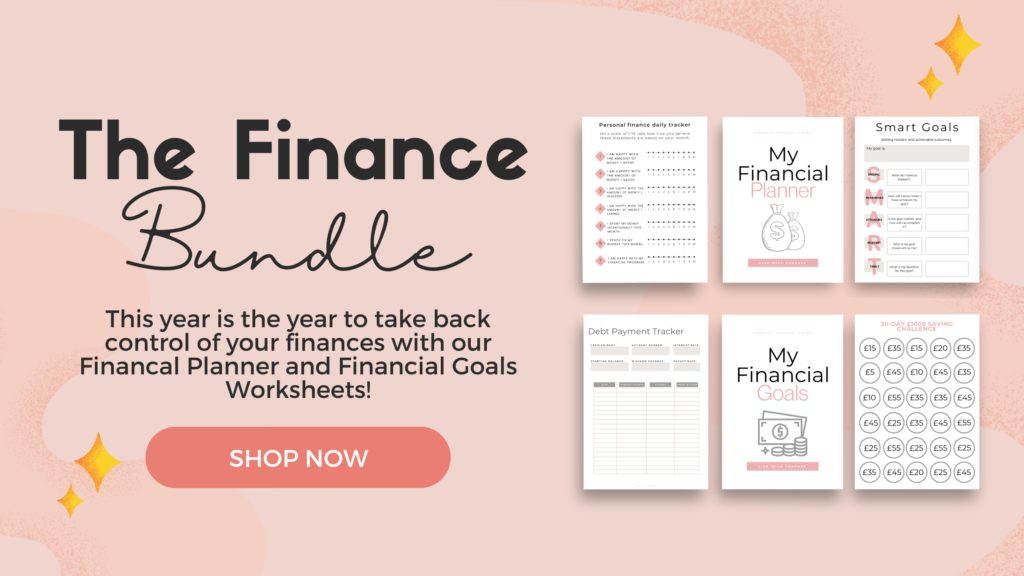
Pursuing Hobbies and Passions
Investing in yourself also means dedicating time to your hobbies and passions. By engaging in activities you enjoy, you’re not only nurturing your creativity and expanding your skillset but also recharging your mind and promoting overall well-being.
Whether it’s painting, dancing, cooking, or writing, make it a priority to carve out time in your schedule to pursue your interests and cultivate joy in your life. 💕
Want to learn simple ways to love yourself? Check out this 10 simple ways to love yourself blog post!
Volunteering and Giving Back
Another powerful way to invest in yourself is by volunteering and giving back to your community. Not only does this provide a sense of purpose and fulfillment, but it can also help you develop new skills, forge meaningful connections, and gain valuable experiences.
Whether it’s through a local non-profit, a professional organisation, or an international volunteer program, seek out opportunities to make a positive impact and grow both personally and professionally. 💼
Conclusion: The Lifelong Benefits of Investing in Yourself
Investing in yourself is the key to unlocking a brighter future, filled with personal growth, success, and fulfillment.
By embracing education and lifelong learning, building a strong professional network, developing essential soft skills, maintaining a healthy lifestyle, cultivating a growth mindset, allocating financial resources towards personal development, pursuing hobbies and passions, and giving back through volunteering, you’re setting yourself up for a life of continuous growth and achievement. 🏆
Remember, you are your most valuable asset, and the investment you make in yourself today will pay dividends for years to come. ❤️
Pin this post for a reminder 📌 👇

Related Blogs
The Top 10 Reasons Why People Don’t Reach Success
In today’s fast-paced world, finding inner peace and serenity can be quite challenging. The constant demands on our time and attention can leave us feeling stressed, anxious, and overwhelmed.
That’s where meditation comes in. 🧘♀️
Meditation is a powerful tool that can help us slow down, quiet our minds, and cultivate a sense of inner calm and balance.
In this guide to meditation, we’ll explore the basics of meditation, its numerous benefits, and various techniques to help you find the practice that’s right for you. It will also provide a step-by-step process for beginners, tips for creating a comfortable meditation space, and resources to support your journey toward a more mindful and tranquil life.
Now let’s get started. 🙌
Understanding the benefits of meditation
Meditation has been practiced for thousands of years across various cultures and traditions. It has gained popularity in recent years due to its numerous physical, mental, and emotional benefits. Plus, who doesn’t love being flexible? 😂
Different types of meditation techniques
There is a wide variety of meditation techniques available to suit different preferences and needs. Some of the most popular methods include:
✨Mindfulness meditation: This practice involves focusing your attention on the present moment without judgment. It can be done by paying attention to your breath, bodily sensations, or a particular object.
Ps: Find out more about mindfulness meditation in The Keys to Self-Mastery eBook

✨Loving-kindness meditation (Metta): This technique involves cultivating feelings of love and compassion for yourself and others. It usually involves repeating phrases such as “May I be happy” and “May all beings be happy”. 😃
✨Body scan meditation: This type of meditation involves mentally scanning your body from head to toe, observing any sensations or tension that may be present.
✨Mantra meditation: This technique involves repeating a word or phrase, either silently or out loud, to help focus your mind and cultivate a sense of inner peace.
✨Visualisation meditation: In this practice, you focus on a mental image, such as a peaceful landscape or a person you admire, to help cultivate positive emotions and a sense of calm.
A beginner’s guide to meditation: Step-by-step process
Starting a meditation practice can seem daunting, but with a simple step-by-step process, you’ll be well on your way to embracing serenity. Here’s how to begin:
🕑Choose a time and place: Find a quiet space where you won’t be disturbed, and set aside a specific time each day for your meditation practice.
🪑Get comfortable: Whether you choose to sit on a cushion, chair, or floor, find a comfortable position that allows you to maintain an upright posture without straining.
😮💨Focus on your breath: Close your eyes, and begin by taking a few deep breaths. Then, let your breath return to its natural rhythm and simply observe each inhale and exhale.
👀Gently redirect your attention: As thoughts and distractions arise, gently acknowledge them and bring your focus back to your breath without judgment.
🧘♀️Be patient: Meditation is a skill that takes time and practice to develop. Be patient with yourself and remember that consistency is key.

Tips for creating a comfortable meditation space
Having a dedicated space for meditation can help support your practice and make it easier to establish a regular routine. Here are some tips for creating a comfortable and inviting meditation environment:
✨Choose a quiet spot: Find a space in your home where you can minimise distractions and noise.
✨Keep it simple: A clutter-free environment can help promote a sense of calm and focus. Keep your meditation space clean and organised.
✨Consider lighting and temperature: Natural light and a comfortable temperature can help create a soothing atmosphere for your meditation practice.
✨Create a ritual: Establishing a pre-meditation ritual, such as lighting a candle or playing soft music, can signal to your mind that it’s time to meditate and help you ease into the practice. Building a great meditation habit!
Overcoming common challenges faced by meditation beginners
As with any new skill, beginners often encounter challenges when starting a meditation practice. Here are some common obstacles and tips for overcoming them:
🥱Restlessness: It’s natural for your mind to wander when you first begin meditating. When this happens, gently bring your focus back to your breath without judgment or frustration. It’s totally normal!
🕒Lack of time: It can be difficult to carve out time for meditation in our busy lives. Start with just a few minutes each day and gradually increase the duration of your practice as you become more comfortable. Look at your current daily routine and see where you think you can slot some time in.
RELATED: Check out our How to set goals and achieve them mini-course!

🙃Impatience: Remember that meditation is a process, and it takes time and consistent practice to experience its full benefits. Be patient with yourself and celebrate your progress along the way.
Incorporating meditation into your daily routine
To experience the full benefits of meditation, it’s important to make it a regular part of your daily routine. Here are some tips for incorporating meditation into your life:
✨Establish a consistent schedule: Choose a specific time each day for your meditation practice and stick to it as consistently as possible.
✨Start small: Begin with just a few minutes of meditation each day and gradually increase the duration as you become more comfortable with the practice.
✨Find opportunities throughout the day: Look for opportunities to practice mindfulness and meditation throughout your day, such as during your morning commute or while waiting in line.
✨Set reminders: Use a calendar or smartphone app to set reminders for your meditation practice to help you stay consistent.
✨Join a meditation group: Participating in a meditation group or attending guided sessions can help you stay motivated and provide support as you deepen your practice.
Tracking your meditation progress
Monitoring your progress can be motivating and help you stay committed to your meditation practice.
Consider keeping a meditation journal to track your experiences, insights, and challenges. You can also use smartphone apps that offer guided meditations and track your sessions to help you stay consistent and monitor your progress over time. 😊

Exploring mindfulness and meditation resources
As you continue to develop your meditation practice, you may find it helpful to explore additional resources and tools to support your journey. Some options include:
📱Apps: Smartphone apps can offer guided meditation sessions, reminders, and tracking tools to help support your practice.
💻Online courses: Many organisations and meditation teachers offer online courses and workshops to help you deepen your understanding and practice.
🏖️Retreats: Attending a meditation retreat can be a transformative experience that allows you to fully immerse yourself in the practice and connect with like-minded individuals.
👭Local meditation groups: Joining a local meditation group can provide a supportive community and the opportunity to learn from experienced practitioners.
Conclusion: Embracing serenity through meditation
Meditation is a powerful tool for cultivating inner peace, reducing stress, and improving overall well-being.
By following this guide to meditation, you’ll be well on your way to embracing serenity and creating a more mindful, balanced life. Remember that patience, consistency, and self-compassion are key elements of successful meditation practice. 😄
As you continue to explore and deepen your practice, you’ll discover the profound benefits of meditation and the transformative impact it can have on your life. ❤️
Pin this post for a reminder 📌 👇

Related Blogs
The Ultimate Guide for Coping with Change
Did you know that people on my email list sometimes get exclusive discounts on my products? Join the community and save yourself some coins!
Freshly-squeezed inspiration, and no-nonsense tips + tricks to improve your life delivered to your inbox weekly.
Subscribe to my newsletter
Subscribe
You're all signed up!
Be sure to whitelist our email address so that all the goodies make it to your inbox.






